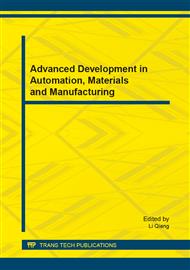[1]
D.W. Gong, C.A. Grimes, O.K. Varghese, et al. J. Mater. Res., 2001, 16(12): 3331-3334.
Google Scholar
[2]
K. Shankar, G.K. Mor, A. Fitzgerald, et al. J. Phys. Chem. C, 2007, 111(1): 21-26.
Google Scholar
[3]
H.E. Prakasam, K. Shankar, M. Paulose, et al. J. Phys. Chem. C, 2007, 111(20): 7235-7241.
Google Scholar
[4]
N.K. Allam, C.A. Grimes. J. Phys. Chem. C, 2007, 111(35): 13028-13032.
Google Scholar
[5]
X.B. Chen, M. Schriver, T. Suen, et al. Thin Solid Films, 2007, 515(24): 8511-8514.
DOI: 10.1016/j.tsf.2007.03.110
Google Scholar
[6]
N.K. Allam, K. Shankar, C.A. Grimes. J. Mater. Chem., 2008, 18(20): 2341-2348.
Google Scholar
[7]
N.K. Allam, K. Shankar, C.A. Grimes. Adv. Mater., 2008, 20(20): 3942-3946.
Google Scholar
[8]
J.M. Macak, M. Zlamal, J. Krysa, et al. Small, 2007, 3(2): 300-304.
Google Scholar
[9]
J.J. Liao, S.W. Lin, L. Zhang, et al. ACS Appl. Mater. Interfaces, 2012, 4(1): 171-177.
Google Scholar
[10]
G.K. Mor, M.A. Carvalho, O.K. Varghese, et al. J. Mater. Res., 2004, 19(2): 628-634.
Google Scholar
[11]
H.F. Lu, F. Li, G. Liu, et al. Nanotechnology, 2008, 19(40): 405504-405600.
Google Scholar
[12]
G.K. Mor, O.K. Varghese, R.H.T. Wilke, et al. Nano Lett., 2008, 8(7): 1906-(1911).
Google Scholar
[13]
M.D. Ye, J.J. Gong, Y.K. Lai, et al. J. Am. Chem. Soc., 2012, 134(38): 15720-15723.
Google Scholar
[14]
K. Shankar, G.K. Mor, H.E. Prakasam, et al. Nanotechnology, 2007, 18(6): 065707-065711.
Google Scholar
[15]
K. Shankar, J. Bandara, M. Paulose, et al. Nano Lett., 2008, 8 (6): 1654-1659.
Google Scholar
[16]
K. Shankar, J.I. Basham, N.K. Allam, et al. J. Phys. Chem. C, 2009, 113(16): 6327-6359.
Google Scholar
[17]
C.A. Grimes. J. Mater. Chem., 2007, 17(15): 1451-1457.
Google Scholar
[18]
G.K. Mor, O.K. Varghese, et al. Sol. Energy Mater. Sol. Cells, 2006, 90(14): 2011-(2075).
Google Scholar
[19]
X.H. Lu, G.M. Wang, T. Zhai, et al. Nano Lett., 2012, 12(3): 1690-1696.
Google Scholar
[20]
X.Q. Chen, X.W. Zhang, L.C. Lei. J. Inorg. Mater., 2011, 26(4): 369-374.
Google Scholar
[21]
X.L. Tian, J. Tao, H.J. Tao, et al. Acta Phys. -Chim. Sin., 2009, 25(6): 1111-1116.
Google Scholar
[22]
P. Supphasrirongjaroen, P. Praserthdam, et al. Chem. Eng. J., 2008, 138(1-3): 622-627.
Google Scholar
[23]
R. Argazzi, C.A. Bignozzi, T.A. Heimer, et al. Inorg. Chem. 1994, 33(25): 5741-5749.
Google Scholar


